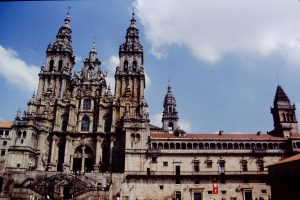 Pilgrims have played an important role in several of my Lady Apollonia West Country Mysteries. Phyllis of Bath in Plague of a Green Man had been on pilgrimage to several religious sites throughout England and Europe. The Prologue of Templar’s Prophecy deals with the pilgrimage of Martin Harlech to Banganarti in Africa where he was desperately seeking healing in the Church of the Archangel Raphael. My latest novel, King Richard’s Sword, begins with the return of Robert Kenwood to Worcester after his pilgrimage to Santiago de Compostela in Northern Spain. This was as important a pilgrimage site for Europeans as were Canterbury, Rome, and Jerusalem. Santiago honours Christ’s martyred apostle, Saint James the Great, about whom are many legends concerning his first century travels there and his death in Spain.
Pilgrims have played an important role in several of my Lady Apollonia West Country Mysteries. Phyllis of Bath in Plague of a Green Man had been on pilgrimage to several religious sites throughout England and Europe. The Prologue of Templar’s Prophecy deals with the pilgrimage of Martin Harlech to Banganarti in Africa where he was desperately seeking healing in the Church of the Archangel Raphael. My latest novel, King Richard’s Sword, begins with the return of Robert Kenwood to Worcester after his pilgrimage to Santiago de Compostela in Northern Spain. This was as important a pilgrimage site for Europeans as were Canterbury, Rome, and Jerusalem. Santiago honours Christ’s martyred apostle, Saint James the Great, about whom are many legends concerning his first century travels there and his death in Spain.
In 2002, I was privileged with my husband, Lou, to follow the ancient pilgrimage route across northern Spain from Roncesvalles in the Pyrenees to Santiago de Compostela in Galicia. Called the Camino de Santiago, it has been designated as a World Heritage Site. Several of the routes from France converge at Puente la Reina in Spain. Our route was one of them before proceeding west from Puente la Reina through Burgos, Fromista, and Leon. The French had influenced some ancient church architecture along the route ranging from Romanesque and Gothic buildings at the time of my novels to Baroque and contemporary in the modern day.
Lou and I found that in the 20th century, there were as many pilgrims to Santiago as in medieval times. During earlier years, after the Protestant Reformation, much of the route had been neglected. Certain villages that depended on the medieval pilgrims were abandoned and deserted. We found many of these reviving with the return of young tourists and pilgrims. Many modern pilgrims walk or ride a horse or donkey as did the medieval pilgrims. Others ride bicycles, take buses, or other modern forms of transportation as we did.
The motives of medieval pilgrims varied greatly. Chaucer’s wife of Bath, on whom my character, Phyllis of Bath, is based travelled to all the major pilgrimage sites and enjoyed herself while being away from home. My characters, Martin Harlech and Robert Kenwood were doing penance to seek healing while on pilgrimage.
The scallop shell is the traditional pilgrimage symbol associated with Santiago. Medieval pilgrims like Robert Kenwood used this symbol of their completer journey as pilgrims do in the present day. Signage on the Camino de Santiago sometimes uses an abstract version of the scallop shell. The symbol is embedded in many streets along the way, starting in France and leading all the way to Santiago. In both the traditional and the abstract versions, lines of the shell come together at one point, symbolising the convergence of different routes coming together at Santiago.
For more on pilgrimage to Santiago, click on
https://en.wikipedia.org/wiki/Camino_de_Santiago
https://en.wikipedia.org/wiki/Santiago_de_Compostela_Cathedral
Tags: Chaucer's England, historical fiction, medieval mysteries, pilgrimage